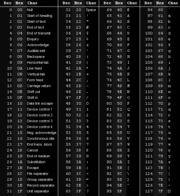User:KSylvester
From WikiEducator
(![]() : Dear Kevon. Great start. Keep going. You are on your way. Please don't forget to complete the infobox with your information and to upload a photo. Warm regards --Patricia 22:53, 26 February 2009 (UTC))
: Dear Kevon. Great start. Keep going. You are on your way. Please don't forget to complete the infobox with your information and to upload a photo. Warm regards --Patricia 22:53, 26 February 2009 (UTC))
| Website: | http://www.pbcgrenada.org | ||
| Employer: | Ministry of Education | ||
| Occupation: | Teacher | ||
| Nationality: | Grenadian | ||
| Country: | Grenada | ||
| |||
|
Contents
Binary
What is Binary
Base 10
In order for us to truly unsderstand Binary, we must first grasp the concept of our normal numbering system.
- Humans use a Base 10 (Denary) counting system.
- This Base 10 system consist of a total of 10 digits (0-9) and can be used to form any number in our counting system.
- Complex numbers are created as a combination of two or more numbers between 0 and 9. e.g. The number 425 consists of the numbers 4,2,5.
- The Denary number system uses Numerical Place Values to accomplish this task.
"Binary is the simplest language on which all other languages can be represented." - Krem Shaw
Numberical Place Values
Each digit in our numbering systems are given what is known as place values, and are dependent on the position of the digit in the entire number. They are arranged as follows:
- Ones
- Tens
- Hundreds
- Thousands
- Tens of Thousands
- Hundreds of Thousands
- Millions
etc.
| Place Values | ||||
| [math]Base_{10}[/math] | Thousands | Hundreds | Tens | Ones |
| 183 | 0 | 1 | 8 | 3 |
| 32 | 0 | 0 | 3 | 2 |
| 9152 | 9 | 1 | 5 | 2 |
Counting in Binary
| 1 | 2 | 3 |
| 4 | 5 | 6 |
| Decimal | Binary | Decimal | Binary | |
|---|---|---|---|---|
| 0 | 0 | 11 | 1011 | |
| 1 | 1 | 12 | 1100 | |
| 2 | 10 | 13 | 1101 | |
| 3 | 11 | 14 | 1110 | |
| 4 | 100 | 15 | 1111 | |
| 5 | 101 | 16 | 10000 | |
| 6 | 110 | 17 | 10001 | |
| 7 | 111 | 18 | 10010 | |
| 8 | 1000 | 19 | 10011 | |
| 9 | 1001 | 20 | 10100 | |
| 10 | 1010 |

